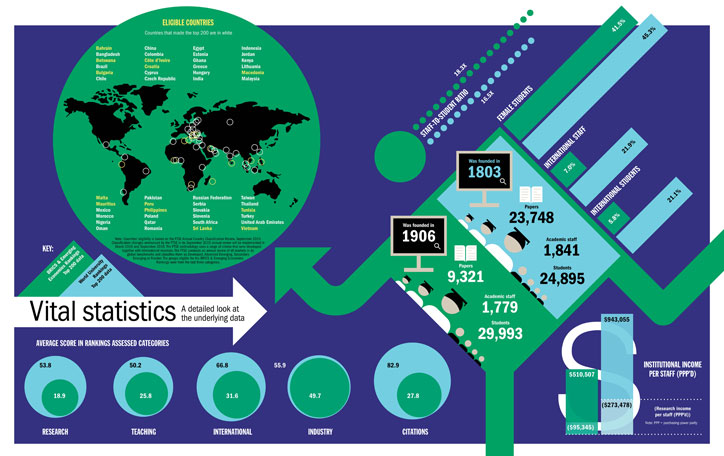View the full results of the BRICS & Emerging Economies Rankings 2016
Developing nations that want to achieve the same level of higher education success as China have a tough journey ahead of them.
China’s research and development spending has increased by an average of 23 per cent a year over the past decade, according to Nature Index, with the goal of reaching 2.5 per cent of its gross domestic product by 2020, up from 1 per cent in 2000.
The People’s Republic’s 15-year science and technology plan, announced in 2006, includes the aim for China to become one of the world’s top five countries for the number of invention patents and most-cited scientific papers.
And earlier this year the country announced a new scheme, dubbed World Class 2.0, with the aim of establishing six of its universities in the leading group of global institutions by 2020, and for some of those to reach top 15 status by 2030. The initiative will include creating hubs for international collaboration with overseas universities and boosting the research base of China’s top nine universities.
“Typically, the research budget of a large Chinese institution would be more than the combined research budget of all [18] Indian Institutes of Technology,” Shiban Koul, deputy director of strategy and planning at the Indian Institute of Technology Delhi, says.
So it is not surprising that China dominates this year’s Times Higher Education BRICS & Emerging Economies Rankings.
The country claims half the top 10 places, which include Beijing neighbours Peking and Tsinghua universities in first and second place, and has 39 universities in the extended top 200 table, 27 of which sit within the first half.
Although THE’s rankings methodology remains largely unchanged, improvements made to the underlying data used to create the tables mean that it is impossible to make direct year-on-year comparisons of the results. Nonetheless, clear insights can be drawn.
While China still stands head and shoulders above the other large emerging BRICS economies, Brazil, Russia and India are all gaining in strength.
India is the only BRICS nation without an institution in the top 10, but it boasts the highest number of universities in the group apart from China and Taiwan. The Indian Institute of Science leads the country’s 16 institutions in 16th place.
Russia has 15 institutions in the top 200, including seven in the top 50, led by Lomonosov Moscow State University in third place.
It is followed by Brazil, which claims 14 universities, with its number one, the University of São Paulo, sitting in ninth place.
South Africa cannot claim to have the same strength in depth as the other developing nations, with six universities in total, but four of its institutions are in the top 50. The University of Cape Town is fourth, the University of the Witwatersrand sixth and Stellenbosch University 11th.
Anatoly Oleksiyenko, associate professor in the division of policy, administration and social sciences education at the University of Hong Kong, says that the trend of China dominating this rankings will continue “as long as the Chinese government and universities create opportunities for free exchange of ideas on their campuses, and continue to enhance collaboration with leading research institutions abroad”.
He suggests that Brazil has the greatest potential of the remaining BRICS nations to generate world-class institutions, if its universities become “more strategic about the use of their transnational intellectual capital and create better synergies among governmental, institutional and individual initiatives”.
However, he warns that there “seems to be a lot of doubt inside the country about their competitive edge and about the sensibility of becoming more competitive”.
Simon Schwartzman, president of the Institute for Studies on Labor and Society based in Rio de Janeiro, shares his concerns, adding that Brazil has to deal with “complicated sets of rules and regulations” that limit its ability to implement selective policies of excellence.
He says that the Brazilian universities that appear in the rankings are those in the richest parts of the country that have established traditions of research that allow them to get additional resources from the state and federal science support agencies.
“However, they are not able to negotiate salaries for their professors, have difficulties raising revenues and linking to the private sector, and their internal administration is bogged down by complex and often politicised collegial procedures, which makes them very ineffective,” he says.
“Recent legislation placed a low cap on the salaries of professors, particularly in the São Paulo system, reducing their ability to attract and retain talent, while the federal system is required to admit 50 per cent of students according to social and racial quotas.”
For Roberta Bassett, senior education specialist working in the World Bank’s Global Practice in Education, “India has always stood on the verge of great higher education prominence – at least at its most elite level” because of its “historically excellent institutions and English-language capacity”.
IIT Delhi’s Koul says that Indian institutions fare “extremely well” in terms of academic parameters such as research papers, citations and reputation of students, but are held back by staff-to-student ratios and the percentage of international staff and students.
IIT Delhi, which is ranked in joint 37th place in the rankings, is “trying to improve both by more aggressive hiring of faculty members and admitting more foreign students”, he says.
He adds that the IIT council is “in the process of evolving models for admitting foreign students, without compromising on entry requirements”, which will allow the institutes to compete better globally.
Although Russia is the country that seems to have made the most progress in higher education in recent years, following the country’s Project 5-100 – launched in 2013 and designed to provide enough federal support to help at least five Russian institutions to enter the world top 100 by 2020 – the nation still has its challenges.
Nikolay Kropachev, rector of Saint Petersburg State University, which is also in joint 37th place in the rankings, says that “foreign partners” still “tend to regard Russian universities and scholars as ‘junior partners’”.
Oleksiyenko adds that Russian institutions had “huge potential” before 2014 but internationalisation of higher education was “compromised following the 2014 crisis in Ukraine, when Russian politicians pulled their country into a major conflict with the West”.
“Over the past two years, the Russian political establishment has only intensified its confrontational policies on the global political arena. These will have long-term effects on the universities’ international collaborations,” he says.
There is a great deal of success outside the major BRICS economies, in part due to this year’s extended table; for the first time this ranking includes 200 universities, double the number featured last year. Overall, 35 countries feature, also double the number in the 2015 list.
Several of these newly featured institutions are in Latin America. Six Chilean universities make the top 200, led by Federico Santa María Technical University in 47th place, while Colombia and Mexico both have two institutions. The National Autonomous University of Mexico is the highest ranked Latin American institution outside Brazil, in 23rd place.
Jorge Balan, senior research scholar at the School of International and Public Affairs at Columbia University, says that Mexico – “due to its size, complexity and proximity to the US” – has the greatest potential of these nations to generate world-class universities, “at least in terms of the number of institutions competing for world-class status”.
However, he says that none of these countries devotes enough funding to research to truly achieve world-class status; their typical budget is about 0.5 per cent of their gross national product while BRICS nations invest 1 per cent to 1.5 per cent of GNP, “often with small but rapidly increasing participation with industry”, he says.
Another region that has a greater share in this year’s extended ranking is Southeast Asia. Seven Thai institutions make the list, led by Mahidol University in 54th place, just ahead of the Universiti Teknologi Malaysia at 56th, which heads up Malaysia’s four representatives. Indonesia is represented for the first time by the University of Indonesia in joint 171st place.
Martin Hayden, professor of higher education at Australia’s Southern Cross University, says that a challenge for these countries is “envisaging the nature of a university as a research-based institution, rather than as one in which teaching is the primary role and in which research is strong only in particular faculties or departments”.
He adds that Thailand has the largest number of universities with established reputations, but Malaysia has the “most focused plan” for enabling a select group of universities to achieve international recognition.
However, Hayden is sceptical about whether any of these countries will be able to achieve a similar level of success as China in the years to come.
“Each of the three countries has universities with well-established national reputations, but there is political caution about investing too heavily in a small, select group of universities,” he says.
“None has China’s capacity to sustain a large number of universities of international significance, and, at least to date, none appears to have been as willing as China to provide the substantial and sustained investment required to enable their leading universities to achieve international prominence as research-based institutions.”
ellie.bothwell@tesglobal.com
Twitter: @elliebothwell
Vital statistics: a detailed look at the underlying data
后记
Print headline: On a trajectory for global success





